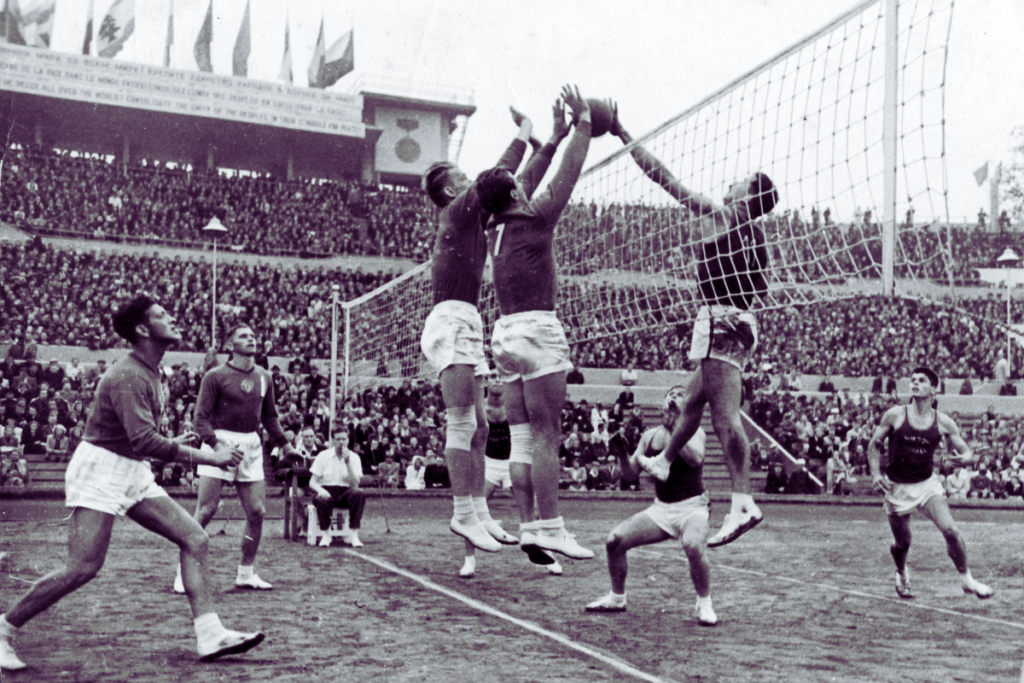Volleyball is loved by millions worldwide! But what makes it so special? Where did it come from?
I uncovered exciting moments, surprising facts, and the story behind the beginning of a global phenomenon.
Join me on a journey to uncover the history of volleyball. Let’s get started.
Background of William G Morgan
William G. Morgan, the inventor of volleyball, was born on January 23, 1870, in Lockport, New York. He grew up with a passion for sports and education, which encouraged him to pursue a career in physical education.
He graduated from Springfield College of the Young Men’s Christian Association (YMCA) from 1892 to 1894. Later began working as a physical education instructor at the YMCA Training School in Holyoke, Massachusetts.
He was a close friend and colleague of James Naismith, the inventor of basketball.
In 1895, Morgan became the director of physical education at the YMCA and became a prominent figure who worked day and night in the development of recreational programs nationwide. Today he is recognized as the “Father of Volleyball” and his legacy extends beyond the sport.
Got Inspiration From
He was dedicated to promoting physical activity and sports as an important part of a healthy lifestyle. Morgan was a talented athlete, excellent in basketball, baseball, and football.
Morgan wanted to create a game that was less physically demanding than basketball, yet still engaging and challenging. Interestingly he combined elements from basketball, tennis, and handball to create volleyball.

Origin of Volleyball
Initially, it was called Mintonette, as his friend, Alfred Halstead (sports editor) suggested “Volleyball” due to the significance of volleys. Morgan’s vision was to create a game accessible to people of all ages and physical abilities.
Morgan’s Gameplay Rules:
The game was played by two teams, each consisting of 9 players. The court size was 25 feet by 50 feet. The ball was made of leather measuring 25-26 cm in circumference. The net was 1.98 meters high and 6.1 meters wide.
The game was divided into 9 innings, with each inning lasting until one team scored 21 points to win. Points were scored when the opponent failed to return the ball.
There were certain positions of the players:
- Center (setter),
- Left/right front (Outside Hitters),
- Left/right back (defensive specialists) and
- 5 middle players (Middle blockers).
The First Game
The first volleyball game was played on July 7, 1896, at the YMCA Training School in Springfield College, Massachusetts, among Morgan’s fellow instructors, colleagues, and some of the businessmen for whom the game was designed. The ball was made of leather, and the net was made of ropes.
The rules were simple: Serve the ball from any part of the court. The concept of rotation was not yet the part of the game and there were no restrictions on how many times a team could hit the ball before sending it over the net.
A team scores points when the opposing team fails to return the ball or, hit it out of bounds.
Gradually, the rules of the games were improved by introducing innovations such as scoring systems and player positions.
Expansion of The Game
The word volleyball quickly spread across the world. The YMCA adopted it as a national program and the first official rules were published in 1900.
Morgan’s efforts led to volleyball’s inclusion in the 1904 World’s Fair.
The first international match was played in 1918 between the United States and Canada. By the 1920s and 1930s, volleyball had been played in many countries in Europe, Asia, and South America.
No one imagined this game would exceed borders and cultures. It is always good to see people from different lifestyles united by this game.
In 1947 the Federation Internationale de Volleyball (FIVB) was founded in Paris. France is the international governing body for the sport. The FIVB played a crucial role in formatting the volleyball rules, establishing international competitions, and extending the sport’s visibility worldwide.
The first Men’s World Championship was organized in 1949 in Prague, Czechoslovakia, making it the first significant international volleyball competition.
In 1957 it was represented as an exhibition sport at the International Olympic Committee (IOC) session in Sofia, Bulgaria. FIVB president Paul Libaud appealed and at an IOC session in 1959 in Munich, the decision was made to include volleyball as an official sport in the Olympic program.
Olympics Debut
Volleyball made its official debut in 1964, at the Tokyo Summer Olympics. Both men’s and women’s indoor volleyball tournaments were included. The competition was among 10 men’s and 6 women’s teams from various countries.
The Soviet Union won the first Olympic gold medal in the men’s team and Japan in the women’s team. It was a pride to watch the world’s best athletes compete.
After the Olympics, volleyball became a global talent and today is played by millions worldwide. It is more than just a game – it is a bridge connecting people, cultures, and generations.
Beach Volleyball’s inclusion
Beach volleyball— a variation of indoor volleyball, made its Olympic debut in the 1966 Summer Olympics in Atlanta.
The first men’s beach volleyball won gold in the USA (Karch Kiraly and Kent Steffes), and the women’s in Brazil (Sandra Pires and Jackie Silva).
The perfect duo of Misty May Treanor and Kerri Walsh Jennings won 3 consecutive gold medals (2004, 2008, 2012) becoming one of the most powerful and successful Olympic teams in history.
The settings of the Horse Guards Parade in London during the 2012 Olympics and Copacabana Beach in Rio de Janeiro during the 2016 Olympics added prestige to the sport by boosting tourism in these areas.
Innovations and Advancements
Since its inception, the game has improved in all aspects, from equipment design to training methods, and player analytics. Modern volleyball balls are made from synthetic materials, reducing weight and increasing durability. Video analysis software helps coaches improve player performance. As of today, it is the second most popular team sport globally after soccer.
The concept of having Libero came in the late 90s as a specialized defensive player who wore a different-colored jersey.
In 1999, FIVB introduced a rally scoring where the points could be scored by either team on every serve, regardless of which team served.
Legacy and Impact
William G Morgan’s legacy extends far beyond volleyball. He contributed remarkably to physical education and sports development, focusing on the importance of physical activity for overall well-being.
Knowing volleyball history helps in
- Understand the game evolution – Learn how volleyball has changed over time, from its inception to modern-day trends.
- Honor the legends – Appreciate William G Morgan and others who shaped the sport contributing to its global popularity.
- Cultural importance – Explore volleyball’s impact on society, culture, and education.
- Worldwide expansion – Discover how volleyball spreads across continents, countries, and communities.
- Appreciate Innovation – Learn about innovations that transformed the game, such as new materials, equipment, and training methods.
The benefits of studying the history of volleyball :
- Learning from past achievements and successes.
- Drawing motivation from legendary players or coaches.
- Understanding the struggles and overcoming challenges.
- Study classic plays and tactics.
- Analyzing historical match data and statistics.
- Identifying patterns and trends.
- Connecting past, present, and future generations.
Take a moment and reflect on what you have learned. Were you surprised to discover that volleyball’s initial name was Mintonette? Or, inspired by the sport’s global reach and impact on communities worldwide. Share your thoughts!

